|
< Earlier Kibitzing · PAGE 3 OF 3 ·
Later Kibitzing> |
| Sep-02-09 | | Gouvaneur: Well played attack by White, guess it was totally unexpected.
Typical double bishop sacrifice, loving it. |
|
| Sep-02-09 | | 310metaltrader: um, i do not see the resignation imperative. the king can escape still at the end. please show me a forced mate at the end? |
|
| Sep-02-09 | | 310metaltrader: never mine, i see that black will have to shed another rook to avoid the next mating web |
|
| Sep-02-09 | | WhiteRook48: nice attack |
|
| Sep-02-09 | | SirChrislov: "Not all artists are chessplayers but all chessplayers are artists." This is an excellent example on how to attack a castled position without a defensive knight on f6. thanks that the rooks were superbly placed on open central files (26.Rd4 was killer!!) and were able to cooperate in the attack. if not, the double bishop sac would've been useless and I'm sure Kolty would've passed on it. "I never really deeply studied "My System", but I do recommend the section on Overprotection, it's very instructive. and I recommend Koltanowski's books, they're very good!"
--Koltanowski |
|
Dec-24-15
 | | eternaloptimist: The Colle System can be fun to play as white but if black plays ...♙g6 & ...♗g7, the ♗ on d3 "bites on granite", & black can normally equalize really easily. Therefore I wouldn't recommend playing the Colle as white in a serious game. |
|
| Sep-28-16 | | dfcx: material is even, black trying to trade bishops. 22.Bxh7+ Kxh7 23.Qh5+ Kg8 24.Bxg7
If black takes the knight,
24...Kxg7 25.Qg5+ Kh7/h8 26.Rd4 and black can stop mate only by giving up the queen. If black refuses the bishop,
24...f6 25.Qh8+ Kf7 26.Bxf8 Rxf8 27.Qh7+ Ke8 28.Rxe6+ wins 25...f5 25.Qh8+ Kf7 26.Bxf8 Rxf8 27.Qh7+ Kf6 28.Qh6+ wins too |
|
| Sep-28-16 | | Cheapo by the Dozen: Easily recognized as a two-bishop sacrifice kind of position. That said, I've never played a game in which I either made such a sacrifice, or planned one, or had one made against me. They're pretty rare. |
|
| Sep-28-16 | | mriddle: I got as far as:
22. Bxh7+ Kxh7 23. Qh5+ Kg8 24. Bxg7 Kxg7 25 Qg5+ Kh8 (instead of Kh7) 26. Rd4 but then what about 26... c6? If 27. Rh4+ Qh7 28. Rxh7+ Kxh7 I don't see a clear win for white yet (Q+2P for R+2B).
White can also try 26. Qf6+ but then Kg8 27. Rd4 Be5 28. Qg5+ Bg7 seems ok for black.
What am I missing? |
|
| Sep-28-16 | | agb2002: The material is identical.
Black threatens Bxe5.
The position looks ready for a double bishop sacrifice 22.Bxh7+: A) 22... Kxh7 23.Qh5+ Kg8 24.Bxg7
A.1) 24... Kxg7 25.Qg5+
A.1.a) 25... Kh7 26.Rd4 Bf4 27.Rxf4 Qxf4 28.Qxf4 + - [Q+2P vs R+B]. A.1.b) 25... Kh8 26.Rd4 f6 27.Rh4+ Qh7 28.Rxh7+ Kxh7 29.Qh5+ followed by 30.Rxe6 + - [Q+2P vs R+B]. A.2) 24... f5
A.2.a) 25.Bxf8 Bf7 (25... B(K,R)xf8 26.Rxe6 + - [R+2P vs B]) 26.Bxd6 Q(R)xd6 (26... Bxh5 27.Bxc7 Rd7 28.Ba5 Bxd1 29.Rxd1 + - [B+2P]) 27.Qg5+ + - [R+2P vs B]. A.2.b) 25.Qh8+ Kf7 26.Bxf8 Bxf8 (26... Rxf8 27.Qh7+ Kf6 -27... Ke8 28.Rxe8+ Kd7 29.Qh6 + - - 28.Qh6+ + -) 27.Qh7+ Bg7 (27... Kf6 28.Qxc7 wins) 28.Rxe6 Kxe6 29.Qg6+ Bf6 (29... Kd7 30.Qxg7+ wins two pawns at least; 29... Ke5 30.Re1+ Kf4 31.Qg3#) 30.Re1+ wins two pawns at least. The option A.2.a looks simpler and better. A.3) 24... f6 25.Bxf8 is similar to A.2.a.
B) 22... Kh8 23.Qh5 Rfe8 24.Bf5+ Kg8 25.Qh7+ Kf8 26.Qxg7+ Ke7 27.Bf6+ Kd7 28.Bxe6+ Kc6 29.Bxd8 is crushing. |
|
| Sep-28-16 | | patzer2: My first thought about today's (22. ?) Wednesday puzzle was it's a rerun. Sure enough I previously saw it in 2004. Whether or not it was memory I don't know, but I had no trouble quickly finding 22. Bxf7+  and the game follow-up. and the game follow-up. The idea behind 22. Bxf7+  is simple: Demolish the King's pawn cover with our Bishops, drive the King to the h-file and lift our Rook to mate or win the Queen. is simple: Demolish the King's pawn cover with our Bishops, drive the King to the h-file and lift our Rook to mate or win the Queen. Black's decisive mistake was 21...Bd6?, allowing 22. Bxf7+  (+6.87 @ 28 depth, Houdini 4x64). (+6.87 @ 28 depth, Houdini 4x64). Instead, 21...Qb6 22. Qf4  (+1.07 @ 28 depth, Stockfish 7) gives Black a fighting chance. (+1.07 @ 28 depth, Stockfish 7) gives Black a fighting chance. Earlier, I like the computer suggestion 10...b6 11. h3 Nh5 = (-0.11 @ 27 depth, Komodo 9.3 64 bit). |
|
| Sep-28-16 | | YouRang: Wednesday 22.?
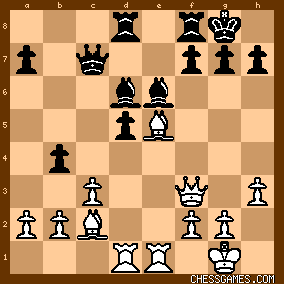
click for larger view
Every so often, we get one of these Bxh7+ puzzles, and that time has come around again. The theme is generally about the same: Use one or two bishops to expose the king, bring the queen in with check, and follow up with a rook lift that threatens mate. Sure enough, <22.Bxh7+ Kxh7 23.Qh5+ Kg8>
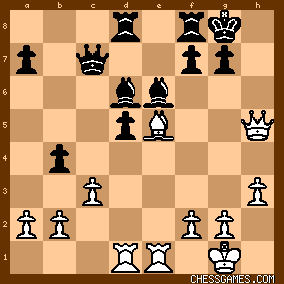
click for larger view
Now comes the other bishop and rook lift: <24.Bxg7 Kxg7 25.Qg5+ Kh7 26.Rd4>
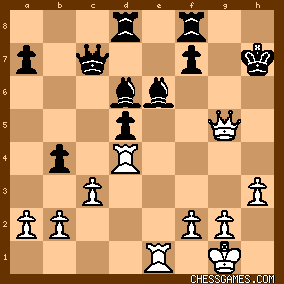
click for larger view
Obviously white threatens Rh4#, and black will need to hemorrhage material to stave off mate. ~~~~~
BTW, black doesn't really fare better by declining either bishop. - After 22.Bxh7+ Kh8? 23.Qh5 threatens Bc2+ ...Kg8 Qh7#. - After 24.Bxg7 f6 (to escape Qh8#) 25.Qh8+ Kf7 26.Bxf8 Bxf8 (not 26.Rxf8 Qh7+ 27.Ke8 Rxe6+  ) 27.Qh7+ Bg7 28.Qh5+ Ke7 29.Qg4 (forks both bishops ) 27.Qh7+ Bg7 28.Qh5+ Ke7 29.Qg4 (forks both bishops  ) )
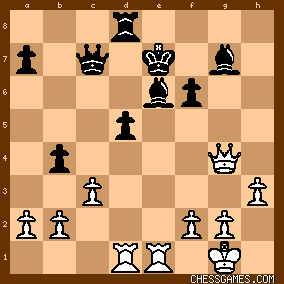
click for larger view |
|
| Sep-28-16 | | AlicesKnight: It was not too hard to see the idea - needs a little caution to use the bishops in the right order (using the check tempi) and finding an entry for the R avoiding the sentry Bs, so 22.Bxh7+ Kxh7; 23.Qh5+ Kg8; 24.Bxg7 Kxg7; 25.Qg5+ Kh7/8; 26.Rd4 and now Black must lose material to survive. |
|
| Sep-28-16 | | mel gibson: It's not that easy to see that 2 bishops can be sacrificed. |
|
| Sep-28-16 | | FrogC: In the hands of Colle and Koltanowski, the Colle System looks like a great attacking weapon, ideal for club players, as it doesn't require much learning of variations. Somehow I've never managed to make it work, though. For one thing, most of my opponents, unlike Black here, are sensible enough to leave the knight on f6. |
|
| Sep-28-16 | | beenthere240: Black was pretty oblivious about the impending attack |
|
Sep-28-16
 | | steinitzfan: It's been a number of years since I've seen this game but it was in the first book I read that described the double bishop sacrifice. |
|
| Sep-28-16 | | lost in space: The Standard Double Bishop sac |
|
| Sep-28-16 | | kevin86: black is the victim of the two bishop sacrifice. Then the long range pieces take over and black is doomed. |
|
Sep-28-16
 | | Jimfromprovidence: I got 22.Bxh7+ Kxh7 23.Qh5+ Kg8 24.Bxg7 Kxg7 25 Qg5+ Kh8 26 Rd4 Bf5 (seeing 26...Bh7, which is the point of 25...Kh8)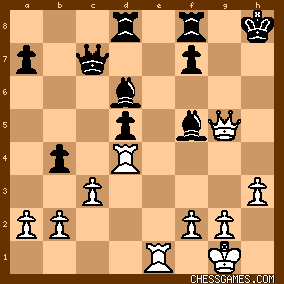
click for larger viewBlack will give one of his bishops back but it still does not matter. Play continues 27 Qxf5 f6 28 Rh4+ Kg8 29 Qh5.
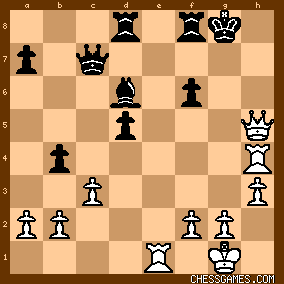
click for larger viewThe threat is mate in 2 after 30 Qh8+. Black must play 29...Qg7 to stop this, then white wins after 30 Rg4. 
click for larger view |
|
Sep-28-16
 | | steinitzfan: <Jimfromprovidence> Interesting line of play. It looks like the move 25...Kh8 would have put White to the test. |
|
| Sep-28-16 | | GoldenKnight: I was glad to get this one! Koltanowski was a good friend of mine. BTW, he pronounced Colle's name as Collie. He would know as Colle was a good friend of his back in the day in Belgium. I think Colle even mentored him to some extent. And I remember as a youngster in the '60s how Koltanowski tirelessly championed his opening, The Colle System. I still have the autographed copy of the book he wrote by that title. |
|
| Sep-28-16 | | whiteshark: ♗♗ sacs!! |
|
| Oct-01-16 | | patzer2: Correction: In my previous post above, I obviously meant to write 22. Bxh7+  and not <22. Bxf7>. and not <22. Bxf7>. |
|
| Apr-01-24 | | Mathematicar: A wonderful attacking game played by one of the pioneers of the Colle System. The opening may seem dull, but compared to London System it is rich and may offer agressive, yet quite positional game by White. |
|
 |
 |
|
< Earlier Kibitzing · PAGE 3 OF 3 ·
Later Kibitzing> |





